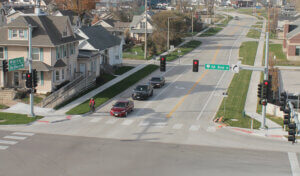

Intersection Safety Capacity Improvements - Cedar Rapids, IA
Traffic Signal Systems
Traffic Signal Operations with an Engineering Foundation
The professionals with Snyder & Associates have decades of experience providing traffic signal system design services for projects ranging from a single, isolated intersection to city-wide signal network systems. These projects include the design of traffic signal systems, improving signal operations, signal timing projects, and comprehensive signal communication plans. Regardless of size or complexity, however, our traffic signal design engineers approach projects with a “complete streets” mindset and often include provisions for turn lane improvements, pedestrian crosswalks and signals, and other multimodal accommodations. Many of these projects also require the need to analyze current and future traffic operations to determine signal phasing and operational needs.
Intelligent Transportation System (ITS)
Another important aspect of traffic signal operations is the application of Intelligent Transportation System (ITS) technology. In most situations, the ITS technology enhances the signal system to ensure traffic operates at an optimal level at all times of the day. As part of our traffic signal designs, commonly included ITS applications are video detection, fiber optic communications, and traffic observation cameras.
Utility Coordination
Traffic signal design often requires careful consideration of competing demands for limited space at an intersection. These include clear zones, pedestrian pushbutton locations, sidewalks, and pedestrian ramps, and utilities. Snyder & Associates has extensive experience coordinating with public and private utilities to achieve optimal designs while minimizing costs or project delays associated with utility relocations.
Traffic Modeling to Solve Problems
Using state-of-the-art traffic modeling software, we analyze traffic signal operational needs and determine traffic signal improvements and modifications to meet those needs. More importantly, we continually strive to promote cost-effective operational improvements that benefit not only our clients and society but also our natural environment.
Snyder & Associates Traffic Signal Systems Services
Traffic Signal Design & Analysis
The design of traffic signals and other traffic control improvements requires a thorough understanding of traffic operations, safety issues, and applicable standards. All of these elements must be considered along with the physical constraints of the project site to create functional, cost-effective improvements.
Traffic Signal System Management & Operations
Effective traffic signal systems management involves the planning, design, integration, maintenance, and proactive operation of a traffic signal system. Our experts can quickly recognize the objectives to improve the efficiency, safety, and reliability of signalized intersection operations.
Traffic Signal Timing
Efficient traffic signal timing and coordination minimizes delays and maximizes progression along a signalized corridor. From data collection and traffic modeling through timing plan development and field implementation, we provide the full range of services necessary to maximize the effectiveness of a signal timing plan.
Intelligent Transportation System (ITS) Technology Design & Systems Engineering
Through the use of advanced communications technology, an Intelligent Transportation System (ITS) improves transportation safety and mobility and enhances productivity. ITS encompasses a broad range of wired and wireless communications-based information and electronics technologies all designed to process and share information that can prevent potential crashes, keep traffic moving, and decrease the negative environmental impacts of transportation on society.
Automated Traffic Signal Performance Measures (ATSPM)
In the past, citizen complaints were typically the primary measure of signalized intersection performance. The use of Automated Traffic Signal Performance Measures (ATSPM) is rapidly changing this dynamic. ATSPM uses high-resolution data collection that allows traffic engineers and technicians to review all intersection events on a cycle-by-cycle basis.
Adaptive Signal Control Technology (ASCT)
Standard traffic signal systems are not capable of accommodating short-term changes in traffic demand without manual adjustments. Adaptive Signal Control Technology (ASCT), however, uses multiple detection methods to gather real-time traffic information along an entire corridor and quickly evaluate and apply an algorithm based on that information. The ASCT implements the updates continually, sharing information between signals to adjust the system’s timing. These constant adjustments accommodate variable traffic patterns and help keep traffic flowing smoothly.
Multimodal Accommodations
Multimodal transportation planning efforts are about more than providing bicycle and pedestrian infrastructure. It’s about building safe, efficient, and attractive transportation networks for users of all ages and physical abilities. From promoting health and fitness to reducing traffic congestion and environmental impact, multimodal transportation is vital to a community’s well-being and sustainability.
Traffic Operations Center Development
For some communities, a central Traffic Operations Center (TOC) is a critical link for observing and making real-time adjustments to traffic systems that help keep the transportation network moving smoothly. The traffic engineers at Snyder & Associates are well-versed in helping our clients develop, implement, and operate cost-effective and productive traffic operations centers for their transportation systems.
Transportation Asset Inventories & Management
Communities vary substantially in terms of their transportation needs, resources, and the complexity of their systems. But most require a method to track and manage these valuable assets. Whether it’s the implementation of a Geographic Information System (GIS) or a robust pavement management system, our team can lead this complex process to determine the right-sized solution to meet all needs.


